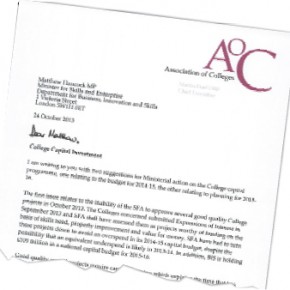After a year in office, Skills Minister Matthew Hancock provides an update on his four priorities for vocational education.
It’s one year since I spoke last at the Association of Colleges (AoC) annual conference.
I’d been a minister for about a month at that point, and I laid out my priorities for vocational education. They were easily summed up as my TASQ — that’s traineeships, apprenticeships, standards and qualifications.
One year on, they’re still the priority, and we’ve achieve a great deal in each area.
Traineeships were launched in August, for example.
The sector responded enthusiastically; more than 500 training providers have pledged to take on trainees, hundreds of companies of all sizes are interested in offering placements.
It is, in fact, one of my proudest achievements as a minister to have seen traineeships become a reality.
They started off as an idea — a way to combine work preparation, work experience, maths, and English. They’re now a programme delivering all those skills and more.
Across traineeships, apprenticeships, standards and qualifications, we’ve achieved a lot in the past 12 months
To make sure that traineeships provide the best possible training we have made an extra £20m available for young people over 19-years-old to take part, too.
The second of my priorities, the A, is apprenticeships.
It was my pleasure last month to launch the Future of Apprenticeships report alongside the Prime Minister at the Mini plant in Oxford.
Even the St Jude’s day storm couldn’t dampen enthusiasm for the new model.
The principle behind the new approach is simple: we want to drive up quality, and simplify the apprenticeship system.
The new standards, which are being crafted by trailblazers in important industrial sectors, will be available by the end of 2014.
They build on the work we’ve already done to improve the apprenticeship brand. We have more apprentices today than ever before, and will continue the good work to increase the 1.5 million new apprenticeship starts since 2010.
Standards are third on my list of priorities. That means raising standards across vocational training, with a particular focus on English and maths.
If we need any evidence this is an urgent task, just look at the OECD’s recent survey of adult skills. It made for grim reading. Out of 24 developed nations, England ranks 22nd for literacy and 21st for numeracy for 16 to 24-year-olds. More damning still is the fact that our young people, fresh from the education system, perform worse than their grandparents.
So we are raising literacy and numeracy standards wherever and whenever we can.
Of course, this includes FE colleges, where we know many who are yet to attain their maths and English GCSE pursue vocational courses.
To help them, we introduced a bursary scheme to attract the brightest and the best to teach English and maths in the FE sector. Talented graduates can access £20,000 when they choose teach in a college.
Which brings me to the Q of my priorities — qualifications.
This month UKCES published the Adult Vocational Qualification Review, which is the latest step to drive up the standards of vocational courses.
We are using this review to inform the decisions being made for a coherent, comprehensible skills system and I recommend that anyone who works in the sector should read it and take on board Nigel Whitehead’s views.
So across traineeships, apprenticeships, standards and qualifications, we’ve achieved a lot in the past 12 months.
They remain my priorities. Just as important, the big picture is the same too — I want us to have a vocational education and skills system that is the envy of the world. That’s what I’m committed to. One year into the job, and with the AoC conference coming round again, it’s every bit as strong.
Mr Hancock is due to be speaking at the Association of Colleges’ conference on Tuesday, November 19, between 12.30 and 2pm in Hall One of Birmingham’s International Convention Centre.






